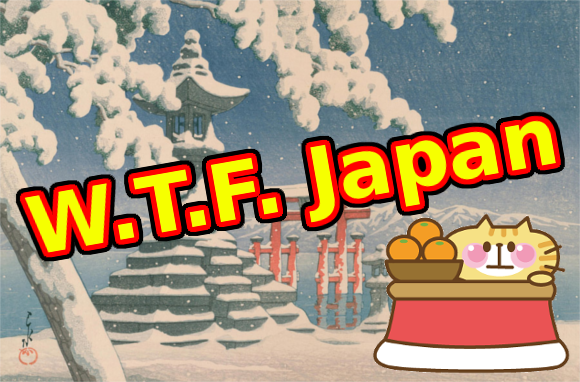
Winter: stay warm inside with some of these cold-weather treats.
A few months ago we looked at the top five Japanese autumn foods, and now that we’re officially well into winter it only seems appropriate to have another Well-Fed Top Five, this time looking at what specialties Japanese people look forward to during the coldest time of year.
That’s why this week we’re counting down the top five Japanese winter foods. Other countries may have pies or eggnog or gingerbread cookies, but Japan has its own winter wonderland of delicacies too.
So let’s get to it! Starting off with…
#5. Sticky like snow: Mochi and zenzai
Ah mochi, the sweet snack made of sticky rice that hospitalizes hundreds of Japanese people every year. As long as you’re careful it can be a tasty treat, but just be careful not to accidentally bite off more than you can chew.
There are several theories as to why mochi is considered a winter food in Japan. One claims that farmers and samurai would eat mochi in winter since it was an easy-to-carry source of dense calories, whereas another claims that mochi was included in boiled soup offerings to Shinto gods around New Year’s, associating them with the holiday.
Whatever the reason, even though mochi can be consumed during any season, there’s one special New Year’s mochi that only comes around once a year: kagami mochi.
▼ Two mochi placed on top of each other with
a Japanese orange on top. It’s like a mochi snowman!
Another popular winter mochi treat is zenzai, possibly one of the strangest sounding yet most delicious things you can eat. It’s a hot soup made from azuki beans (sweet red beans) with a couple of mochi thrown in for good measure.
Again, it may sound bizarre (hot sweet soup???) but it’s basically the Japanese equivalent of a cup of soul-warming hot chocolate. It’s perfect for when you’ve spent a day out in the cold and just want to warm up from the inside out.
▼ Hot, steamy zenzai and its mochi
companions in several different forms.
▼ And just like everything else in Japan,
zenzai too can be cute-ified.
おやつに夫が先週から食べたがってたぜんざいを作ったよー白玉粉と豆腐で作ったアザラシと花を入れてお先にちょっと味見〜 pic.twitter.com/LCdQqYZjYx
— ふむふむ (@emptyblue7) December 13, 2016
#4. The convenience store classic: oden
There are many signs of winter coming: the first cold breeze, snowflakes falling, nighttime in the afternoon. But in Japan one sign stands above the rest to show that winter has truly arrived – convenience stores selling oden.
Oden is somewhat similar to chicken soup in the West; a hot soup that you can technically eat anytime, but people really get excited about during the cold season. Around the middle of fall and all through winter, convenience stores put out metal containers full of oden ingredients so that you can mix and match exactly what you want in your bowl.
▼ It can be a little intimidating at first, but luckily
we have a guide to oden ingredients and how to order it.
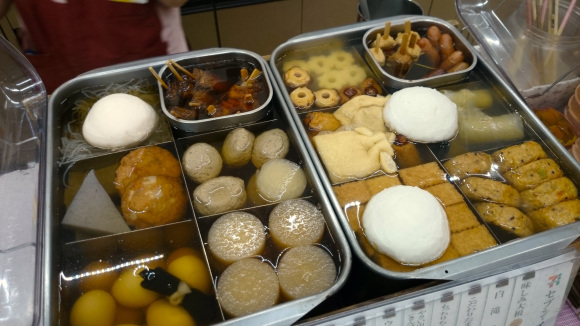
It’s really hard not to like oden, considering there’s basically something for everyone in it, and you can put in and leave out whatever you’d like. Like fish? Be sure to add a nice spongy chikuwa fish-cake tube. Like vegetables? Add in some tender daikon. Like mochi? Add in a mochiiri kinchaku, a mochi wrapped in an inari sushi “pouch.” Like chicken? Add in tsukune, basically chicken meatballs.
And then on top of that there’s eggs, tofu, cabbage, and so much more that can go into it. But no matter what you add, you’re guaranteed to end up with a bowl of warm broth and hearty food to keep you satiated during the cold weather.
▼ Just be sure to keep your oden out of reach of any cats.
<おでんをツンツンするぼく。 pic.twitter.com/796ai4whPW
— えくすぱ (@expa_hoihoi) December 15, 2016
#3. Winter fruits: mikan, strawberries, kaki and yuzu
Not all winter foods are hot and steamy. Sometimes you need something cooler in the winter too, and that’s where Japanese winter fruits come in.
The number one fruit most associated with winter is mikan, Japanese mandarins. One of the most popular Japanese winter pastimes is sitting at the kotatsu (heated table with a blanket) and enjoying some mikan with friends and family… or just by yourself because hey, don’t let a lack of friends stop you from getting your kotatsu and mikan on.
▼ Less humans = less people to have to share with.
12月になったので、コタツを出したのです🐰💕✨#こたつ #みかん #ピョンパレ pic.twitter.com/hpZjQgfSfQ
— ポンパレ (@ponpare) December 5, 2016
Aside from mikan, other popular winter fruits include strawberries, kaki (persimmons), and yuzu (yellow citrus fruit). The harvest season for all the fruits is during the cold season, and while they are often eaten raw, you also see them used in wintertime sweets such as…
▼ …strawberries on Christmas cakes…
https://twitter.com/depanavi_kansai/status/804520760802996224▼ …dried kaki that taste a whole lot sweeter than they look…
ちなみにタイワンの干し柿は日本のと違って圧縮軸が違う(?) pic.twitter.com/WaTdjHAqpe
— justinhsu (@Justinhsu13) December 15, 2016
▼ …and yuzu mochi for a dessert that combines two wintry snacks into one.
人気☆「ゆず」の花言葉は健康美!ゆずスイーツを食べれば健康に!?
— 手土産・ギフト情報配信中@ippin(イッピン) (@ippintw) November 25, 2016
⇒https://t.co/wEIkiiGChS
「健康美」に一歩も二歩も近づくために選びたい、ゆずがたっぷり使われたスイーツをピックアップ! pic.twitter.com/Olx5e1GivP
#2. Simmering deliciousness: sukiyaki and shabu shabu
What’s better than having a steaming bowl of soup and savory bits to yourself during the winter? Doing all of that, but sharing with friends and family!
Sukiyaki and shabu shabu let you do just that. For those who have never experienced the joy of sharing a simmering bowl before, it’s basically a pot placed in the middle of the table filled with broth, meat, tofu, vegetables, and more that is constantly cooking. Some people place the pot on top of a heating plate, some people use special pots that heat themselves, but it’s all essentially the same idea.
▼ Cute mouse ears and noses are not required.
すき焼きパーティー🎉 pic.twitter.com/75x5edToqH
— 野口祐輝(yuki/noguchi) (@WQVTcOUFvBg14Qa) December 6, 2016
Sukiyaki literally means “things you like cooked,” so you basically just use your chopsticks to put in and pick out whatever you want, optionally dip it in a bowl of raw egg (again, a lot better than it sounds), and then eat.
Shabu shabu (the onomatopoeia for “swishing in a pot”) is essentially the same thing, though the meat is thinner. Shabu shabu meat (often beef) is meant to just get a light cooking in the pot, whereas thicker sukiyaki meat (often pork) can be boiled until fully-cooked.
▼ What everyone’s eyes turn into
when they see all-you-can-eat shabu shabu.
And the #1 Japanese winter food is…
.
.
.
.
.
.
.
.
.
.
1. New Year’s feast: osechi ryori
There it is – the big one, the meal that you can really only have on New Year’s or else people will think you’re weird: osechi ryori. It’s a once-a-year feast that consists of, well, pretty much anything you can imagine, and each item has its own symbolic reasons for inclusion.
We’ve talked about the meaning behind pretty much every inclusion in osechi ryori before, but here’s just a few examples:
• Daidai oranges: daidai can also mean “generation after generation,” symbolizing children and health.
• Sea bream: pronounced tai in Japanese which is close to medetai (“auspicious”).
• Herring roe: the many eggs symbolizing many future descendants.
• Ozoni: soup with meat and mochi, which symbolizes long life with its stretchiness.
• Shrimp: the curved bodies supposedly look like the elderly, also symbolizing long life.
And so on and so on. Osechi ryori is the big meal of the year in Japan, kind of like combining Thanksgiving and Christmas dinner in the U.S. into one feast. And even though it’s not as popular as it used to be, it’s still the number one winter meal for Japanese people, considering it’s the only thing on this list that is basically never eaten at any other time of the year. It’d be like having a glass of eggnog in the summer, or a bag of candy corn in spring.
Despite osechi ryori’s detractors though, you have to admit it looks beautiful. And even if you’re not a huge fan of the food itself, there’s Star Wars osechi, Frozen osechi, and even Pokémon osechi to get excited about.
▼ The best way to get kids – and kids at heart – to
eat anything is to serve it in a Pokéball.
So there you have it, the top five Japanese winter foods. Did we miss any of your favorites? Let us know in the comments, and be sure to check out the top five strange things Japanese people do for Christmas for some other interesting winter food choices in Japan.
References: HORTI, Hime Kazura
Top image: GAHAG (1, 2) (edited by RocketNews24)
W.T.F. Japan will be back next Thursday. In the meantime, give me a follow on Twitter and let me know if there’s any topics you’d like to see covered. See you next week!

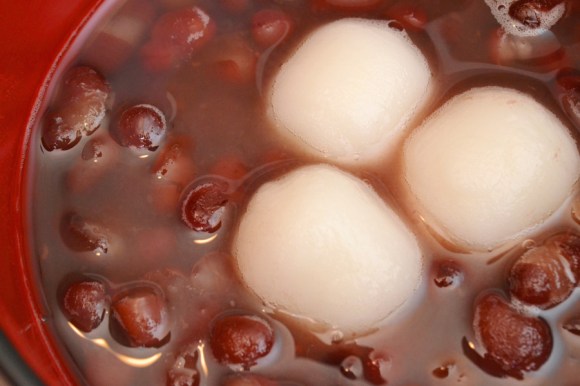
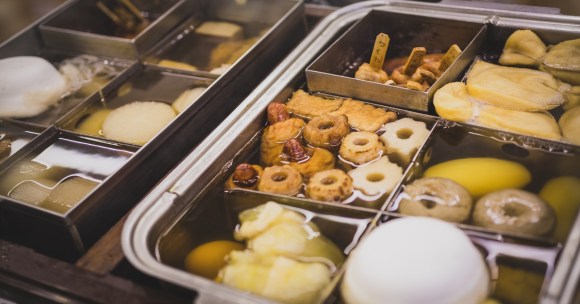
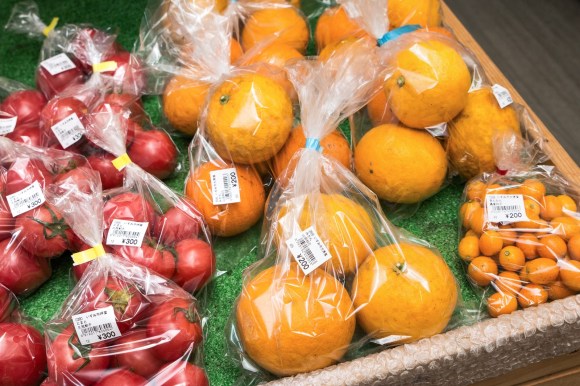
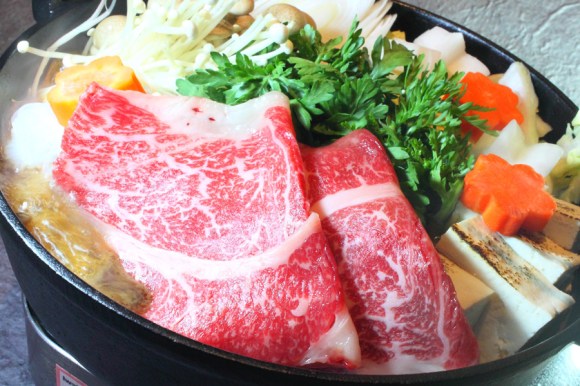
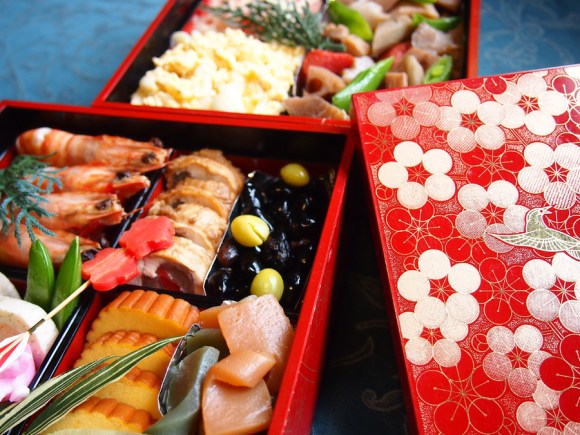
 W.T.F. Japan: Top 5 Japanese spring foods【Well-Fed Top Five】
W.T.F. Japan: Top 5 Japanese spring foods【Well-Fed Top Five】 W.T.F. Japan: Top 5 Japanese autumn foods 【Well-Fed Top Five】
W.T.F. Japan: Top 5 Japanese autumn foods 【Well-Fed Top Five】 W.T.F. Japan: Top 5 hardest Japanese habits to break 【Weird Top Five】
W.T.F. Japan: Top 5 hardest Japanese habits to break 【Weird Top Five】 W.T.F. Japan: Top 5 biggest Japanese food challenges【Weird Top Five】
W.T.F. Japan: Top 5 biggest Japanese food challenges【Weird Top Five】 W.T.F. Japan: Top 5 best Tamagotchi releases 【Weird Top Five】
W.T.F. Japan: Top 5 best Tamagotchi releases 【Weird Top Five】 The Purple Lucky Bag from Village Vanguard is an extra-large waste of money
The Purple Lucky Bag from Village Vanguard is an extra-large waste of money Private booths are coming to Japan’s Shinkansen bullet trains even sooner than we’d thought【Video】
Private booths are coming to Japan’s Shinkansen bullet trains even sooner than we’d thought【Video】 Japanese beef bowl chain Sukiya’s 2026 Smile Box lucky bag basically pays for itself
Japanese beef bowl chain Sukiya’s 2026 Smile Box lucky bag basically pays for itself Rakuten randomly offers 58 New Year’s osechi feasts in Japan, but did we get a star or a dud?
Rakuten randomly offers 58 New Year’s osechi feasts in Japan, but did we get a star or a dud? Only 75 of this gigantic anniversary Moomin plush from Japan will be made: get your orders in!
Only 75 of this gigantic anniversary Moomin plush from Japan will be made: get your orders in! Majority of Japanese mayors say foreign residents are essential but most see good and bad effects
Majority of Japanese mayors say foreign residents are essential but most see good and bad effects Should you dip your cake in sake? One Japanese brewer says no, but actually yes【 Taste test】
Should you dip your cake in sake? One Japanese brewer says no, but actually yes【 Taste test】 7 great places to see Mt. Fuji from without having to climb it
7 great places to see Mt. Fuji from without having to climb it How to cook miso soup (the right way) in a few simple steps【RocketKitchen】
How to cook miso soup (the right way) in a few simple steps【RocketKitchen】 Brand-new Pokémon park opens in Japan with larger-than-life-size Lapras【Photos】
Brand-new Pokémon park opens in Japan with larger-than-life-size Lapras【Photos】 Starbucks Japan ready to get Year of the Horse started with adorable drinkware and plushies【Pics】
Starbucks Japan ready to get Year of the Horse started with adorable drinkware and plushies【Pics】 Hayao Miyazaki says Happy New Year to Studio Ghibli fans with new art for Year of the Horse
Hayao Miyazaki says Happy New Year to Studio Ghibli fans with new art for Year of the Horse We found possibly the quietest Japanese-style hotel in Tokyo’s bustling Shinjuku district
We found possibly the quietest Japanese-style hotel in Tokyo’s bustling Shinjuku district Cup Noodle tries an authentic Jiro-style ramen, but something’s not quite right
Cup Noodle tries an authentic Jiro-style ramen, but something’s not quite right The best Starbucks Japan Frappuccinos we want to drink again in 2026
The best Starbucks Japan Frappuccinos we want to drink again in 2026 We revisited Sweets Paradise after a decade to see if Japan’s dessert buffet still delivers
We revisited Sweets Paradise after a decade to see if Japan’s dessert buffet still delivers That time Seiji called JASRAC to ask why he didn’t get paid royalties for his song being on TV
That time Seiji called JASRAC to ask why he didn’t get paid royalties for his song being on TV Japan’s oldest largetooth sawfish in captivity back on display in Mie Prefecture
Japan’s oldest largetooth sawfish in captivity back on display in Mie Prefecture Pizza Hut Japan’s hot lucky bags are perfect for a New Year’s pizza party
Pizza Hut Japan’s hot lucky bags are perfect for a New Year’s pizza party 7-Eleven Japan starts new temporary luggage storage service in over 300 branches
7-Eleven Japan starts new temporary luggage storage service in over 300 branches Disillusionment at Tsukiji’s tourist-target prices led us to a great ramen restaurant in Tokyo
Disillusionment at Tsukiji’s tourist-target prices led us to a great ramen restaurant in Tokyo Starbucks teams up with 166-year-old Kyoto doll maker for Year of the Horse decorations【Photos】
Starbucks teams up with 166-year-old Kyoto doll maker for Year of the Horse decorations【Photos】 Tokyo considering law requiring more trash cans following litter increase in heavily touristed area
Tokyo considering law requiring more trash cans following litter increase in heavily touristed area Tokyo’s Tsukiji sushi neighborhood asks tour groups to stay away for the rest of the month
Tokyo’s Tsukiji sushi neighborhood asks tour groups to stay away for the rest of the month Tokyo event lets you travel back in time, for free, to celebrate 100 years since Showa era start
Tokyo event lets you travel back in time, for free, to celebrate 100 years since Showa era start Japan may add Japanese language proficiency, lifestyle classes to permanent foreign resident requirements
Japan may add Japanese language proficiency, lifestyle classes to permanent foreign resident requirements Sanrio theme park in Japan announces plans to expand into a Sanrio resort
Sanrio theme park in Japan announces plans to expand into a Sanrio resort Stamina-destroying “Paralysis Noodles” are Tokyo’s newest over-the-top ramen innovation
Stamina-destroying “Paralysis Noodles” are Tokyo’s newest over-the-top ramen innovation Survey asks foreign tourists what bothered them in Japan, more than half gave same answer
Survey asks foreign tourists what bothered them in Japan, more than half gave same answer Japan’s human washing machines will go on sale to general public, demos to be held in Tokyo
Japan’s human washing machines will go on sale to general public, demos to be held in Tokyo Japan’s deadliest food claims more victims, but why do people keep eating it for New Year’s?
Japan’s deadliest food claims more victims, but why do people keep eating it for New Year’s? We deeply regret going into this tunnel on our walk in the mountains of Japan
We deeply regret going into this tunnel on our walk in the mountains of Japan Studio Ghibli releases Kodama forest spirits from Princess Mononoke to light up your home
Studio Ghibli releases Kodama forest spirits from Princess Mononoke to light up your home Major Japanese hotel chain says reservations via overseas booking sites may not be valid
Major Japanese hotel chain says reservations via overseas booking sites may not be valid Put sesame oil in your coffee? Japanese maker says it’s the best way to start your day【Taste test】
Put sesame oil in your coffee? Japanese maker says it’s the best way to start your day【Taste test】 No more using real katana for tourism activities, Japan’s National Police Agency says
No more using real katana for tourism activities, Japan’s National Police Agency says Starbucks Japan reveals new sakura drinkware collection, inspired by evening cherry blossoms
Starbucks Japan reveals new sakura drinkware collection, inspired by evening cherry blossoms Updated cherry blossom forecast shows extra-long sakura season for Japan this year
Updated cherry blossom forecast shows extra-long sakura season for Japan this year W.T.F. Japan: Top 5 Japanese foods for people who don’t like seafood 【Weird Top Five】
W.T.F. Japan: Top 5 Japanese foods for people who don’t like seafood 【Weird Top Five】 W.T.F. Japan: The top five “sora” references of all time! 【Weird Top Five】
W.T.F. Japan: The top five “sora” references of all time! 【Weird Top Five】 W.T.F. Japan: Top 5 most hilarious Japanese euphemisms 【Weird Top Five】
W.T.F. Japan: Top 5 most hilarious Japanese euphemisms 【Weird Top Five】 W.T.F. Japan: Top 5 odd ways Japanese people beat the summer heat【Weird Top Five】
W.T.F. Japan: Top 5 odd ways Japanese people beat the summer heat【Weird Top Five】 W.T.F. Japan: Top 5 nicest sounds in Japan【Weird Top Five】
W.T.F. Japan: Top 5 nicest sounds in Japan【Weird Top Five】 W.T.F. Japan: One year anniversary special! Top 5 W.T.F. Japan articles 【Weird Top Five】
W.T.F. Japan: One year anniversary special! Top 5 W.T.F. Japan articles 【Weird Top Five】 W.T.F. Japan: Top 5 creepiest Japanese insects 【Weird Top Five】
W.T.F. Japan: Top 5 creepiest Japanese insects 【Weird Top Five】 W.T.F. Japan: Top 5 strangest Japanese home goods【Weird Top Five】
W.T.F. Japan: Top 5 strangest Japanese home goods【Weird Top Five】 W.T.F. Japan: Top 5 kanji with the longest readings 【Weird Top Five】
W.T.F. Japan: Top 5 kanji with the longest readings 【Weird Top Five】 W.T.F. Japan: Top 5 creepiest Japanese animals 【Weird Top Five】
W.T.F. Japan: Top 5 creepiest Japanese animals 【Weird Top Five】 W.T.F. Japan: Top 5 confusing Japanese hand gestures【Weird Top Five】
W.T.F. Japan: Top 5 confusing Japanese hand gestures【Weird Top Five】 W.T.F. Japan: Top 5 most famous pet dogs in Japan【Weird Top Five】
W.T.F. Japan: Top 5 most famous pet dogs in Japan【Weird Top Five】 W.T.F. Japan: Top 5 confusing Japanese Internet slang words 【Weird Top Five】
W.T.F. Japan: Top 5 confusing Japanese Internet slang words 【Weird Top Five】 W.T.F. Japan: Top 5 most ridiculous kanji handwriting shortcuts【Weird Top Five】
W.T.F. Japan: Top 5 most ridiculous kanji handwriting shortcuts【Weird Top Five】 W.T.F. Japan: Top 5 most annoying sounds in Japan 【Weird Top Five】
W.T.F. Japan: Top 5 most annoying sounds in Japan 【Weird Top Five】
Leave a Reply